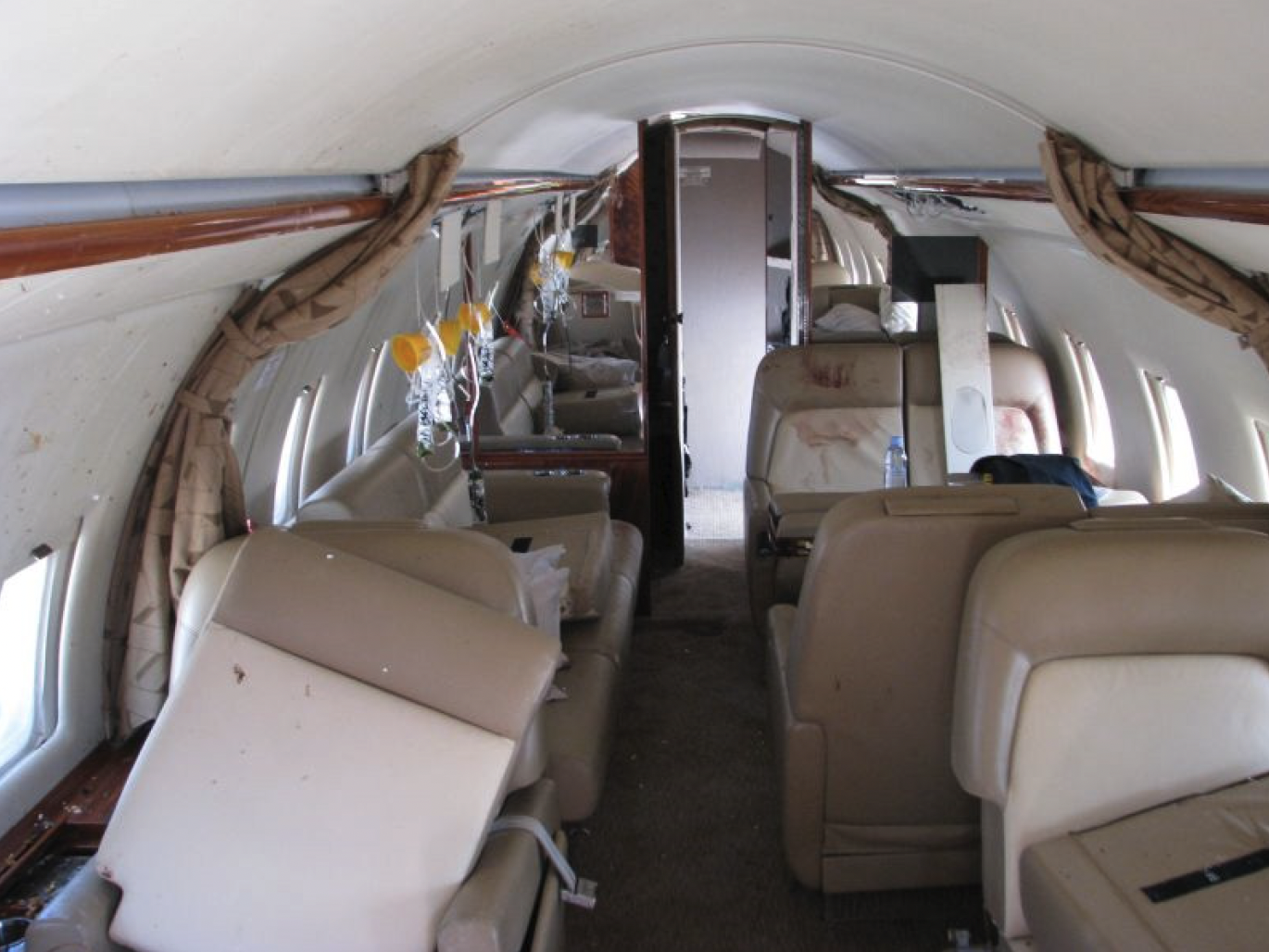When it comes to flying the Strategic Lateral Offset Procedures (SLOP), there are three types of pilots: (1) Those that apply SLOP whenever legal to do so, (2) Those who do so only over establish tracks, and (3) Those that never apply SLOP, reasoning the other guy is doing so and that is good enough. After this incident, everyone should be convinced to join the first camp.
— James Albright

Updated:
2024-05-01
It seems some pilots aren't worried about Wake Turbulence when at altitude because they assume air traffic control will take care of air traffic separation. There are two problems with this. First, ATC is designed, staffed, and overseen by humans who make mistakes. Second, we don't fully understand the wake generated by some airplanes. The Boeing 757 surprised the industry with a wake that exceeded engineering specifications and required the rules be rewritten. Then that happened all over again with the Airbus A380. There were 9 people on this Challenger on January 7, 2017. They came very close to becoming fatalities.

1
Accident report
- Date: 7 January 2017
- Time: 08:39
- Type: Canadair CL-600-2B16 (Challenger 604)
- Operator: MHS Aviation
- Registration: D-AMSC
- Fatalities: 0 of 3 crew, 0 of 6 passengers
- Aircraft Fate: Damaged beyond repair
- Phase: En route
- Airport: Malé International Airport, Maldive Islands, VRMM (Departure)
- Airport: Abu Dhabi-Bateen Airport, United Arab Emirates, OMAD (Destination)
2
Narrative
History of the flight
At 1152 hrs (0652 UTC) the CL604 had taken off from runway 36 at Malé, Maldive Islands, for a flight to Al-Bateen, United Arab Emirates. Three crew members and six passengers were on board the airplane. The Flight Data Recorder (FDR) recordings show that the CL604 autopilot had been engaged approximately one minute after take-off. At 0720 UTC the airplane reached cruise level FL 340. At 0729 UTC the aircraft entered Indian airspace (Mumbai FIR) at the reporting point BIBGO and had received the clearance to fly to reporting point KITAL via route L894. At approximately 0818 UTC the co-pilot radioed reaching reporting point GOLEM.
At 0655 UTC an Airbus A380-861 (A380) had taken off at Dubai Airport, United Arab Emirates, for a flight to Sydney, Australia. The aircraft flew at FL 350 with a southern heading.
The analysis of the flight data of both aircraft showed that at 0838:07 UTC the A380 had passed the CL604 overhead with a vertical distance of 1,000 ft. At 0838:54 UTC the CL604, with engaged autopilot, began to slightly roll right. At the same time a counter-rotating aileron deflection was recorded and fluctuation of the vertical acceleration began. In the subsequent approximately 10 seconds the airplane had a right bank angle of 4° to 6°. At 0839:03 UTC the right bank angle began to increase. Within one second the bank angle increased to 42° to the right. At the same time the aileron deflection to the left increased to 20° and the vertical acceleration to 1.6 g. In the following second vertical acceleration changed to -3.2 g.
At 0839:04 UTC a lateral acceleration of 0.45 g to the right was recorded. The pitch angle changed from about 3° to about 1°, then within one second increased to 9° and decreased again in the following second to -20°. At the same time the FDR recorded a rudder deflection to the left reaching 11.2° after about two seconds whereas the bank angle changed from 42° right to 31° left.
Between 0839:05 UTC and 0839:10 UTC Indicated Airspeed (in knots) changed from approximately 277 KIAS to 248 KIAS. The N1 of the left engine of 95% began to decrease.
At 0839:07 UTC the validity of IRS parameter is lost, the lateral acceleration reached 0.94 g left, the autopilot disengaged, and a master warning, lasting seven seconds, was recorded. Between 0839:09 UTC and 0839:41 UTC the FDR recorded a loss of altitude of approximately 8,700 ft. Large control surface deflections and acceleration were recorded. The speed increased and at 0839:31 UTC reached approximately 330 KIAS. At 0839:30 UTC the spoilers extended and 13 seconds later were retracted again. The N1 of the left engine had decreased to approximately 40% when the Interstage Turbine Temperature (ITT) began to increase and nine seconds later had reached 850°. The left engine was shut off.
At about 0856 UTC the Pilot in Command (PIC) informed the air traffic controller in Mumbai of the occurrence, declared emergency, and reported their position, altitude and their intention to fly via KITAL to Oman.
At about 0915 UTC the crew restarted the left engine. Subsequently the airplane climbed to FL 250. At about 0956 UTC the autopilot was re-engaged.
At 1105 UTC the CL604 landed at Muscat Airport. The A380 continued the flight to Sydney and landed there at 1958 UTC.
Source: BFU17-0024-2X, pp. 2 - 3
Statements of the CL604 Pilots
According to the statement of the CL604 pilots the PIC was Pilot Flying (PF) and the co-pilot Pilot Non Flying (PNF). The PIC stated that TCAS had drawn his attention to the opposite traffic. He then recognised the aircraft type A380, the airline, and informed the co-pilot. The PIC also stated that the A380 had passed them in opposite direction, slightly to the left and according to TCAS 1,000 ft above. He further stated that a short time later the airplane had been hit by the wake turbulence of the A380. The airplane had shook briefly, then rolled heavily to the left and the autopilot disengaged. Both pilots had actuated the aileron to the right in order to stop the rolling motion. But the airplane had continued to roll to the left thereby completing several rotations. Subsequently both Inertial Reference Systems (IRS), the Flight Management System (FMS), and the attitude indication failed. According to the pilots' statements at the time of the accident both pilots had fastened their lap belts and in addition the co-pilot had worn his shoulder belts. According to the PIC he had lost his headset during the rolling motion of the airplane. The Quick Reference Handbook (QRH) had flown around the cockpit and was damaged. As a result individual pages had been scattered around the cockpit. The PIC explained since the sky had been blue and the ocean's surface almost the same colour he had been able to recognise the aircraft's flight attitude with the help of the clouds.
Source: BFU17-0024-2X, p. 4
Statement of the Flight Attendant
The flight attendant stated in an interview conducted by the BFU that during take-off and climb she had been seated in the jump seat with the seat belt fastened. She had opened the seat belt while they were passing FL100. At the time of the accident she had been standing in the middle of the cabin preparing the service. Four of the six passengers had also not been seated. In her recollection the airplane had turned three times around its longitudinal axis, during which the occupants had been thrown against the ceiling and the seats. Several of the passengers suffered injuries, some of which were bleeding. She herself suffered minor injuries. Using the on-board first aid kit she had attended to the passengers. In the further course of the flight she informed the pilots of the situation in the cabin and reassured the passengers.
Source: BFU17-0024-2X, p. 5
Damage to the aircraft
The aircraft manufacturer determined that the airframe structure could not be restored to an airworthy state as it exceeded the airframe certification design load limits during the upset encounter. Therefore the aircraft is considered to be damaged substantially.
During a BFU investigation of the airplane no outer damages on fuselage, wings, and empennage, including control surfaces, were visible. There was no evidence of leakages (oil, fuel).
The inside of the passenger cabin showed damages on the seats and the panelling, as well as traces of blood. The armrests of the four seats in the front, installed in club arrangement, were either deformed or had fractured.
Source: BFU17-0024-2X, pp. 12 - 13
3
Analysis
In accordance with international regulations for airspaces with Restricted Vertical Separation Minima (RVSM) the RVSM for Mumbai FIR between airplanes with RVSM approval was 1,000 ft vertical between FL 290 and FL 410.
Source: BFU17-0024-2X, p. 15
Whenever I hear that an A380 is in the area, I try to keep tabs on its location. If it is 1,000 feet above me, I'll speak up and request a vector out of the way or a change in altitude. The Indian Aeronautical Information Publication ENR 3.0-7 does allow SLOP in this region up to 2.0 NM to the right. I think that might have been enough to prevent this incident from happening.
The case for expanding the wake turbulence envelope around the A380
An ad hoc Steering Group (SG) and a technical Work Group, comprising representatives from Joint Aviation Authorities (JAA), Eurocontrol, Federal Aviation Administration (FAA), Airbus and Det Norske Veritas (DNV), was set up in 2003 to specify safety requirements to ensure Wake Vortex Encounter (WVE) risk from the Airbus A380 will be acceptable. A safety case (A380 SG, 2006a) and supporting documentation has been produced. Among others the following recomendations have been made:
Measurements of WV descent indicate that during the cruise WVs from B744, A346 and A388 aircraft can descend more than 1000 feet; other Heavy aircraft are expected to have similar WV characteristics. [ . . . ] Lighter aircraft should be aware of possible encounters for up to 20 NM behind (horizontal longitudinal) and 1000 feet below a Heavy or A388 generator aircraft, especially when the aircraft are flying close to parallel tracks. Based on current separation criteria, WVE risk is considered to be acceptable at this time.
Source: BFU17-0024-2X, pp. 17 -18
Although the report says the vortices can descent more than 1000 feet, it does nothing other than recommend further review. Changes were eventually made, but I would argue the changes may not be good enough. (See: Wake Turbulence.)

Damage to cabin, BFU17-0024-2X, p. 14
4
Cause
As I write this, seven years after the incident, the final report has still not been released.
References
(Source material)
Interim Report, Bundesstelle für Flugenfalluntersuchung (BFU), 7 January 2017, BFU17-0024-2X, May 2017